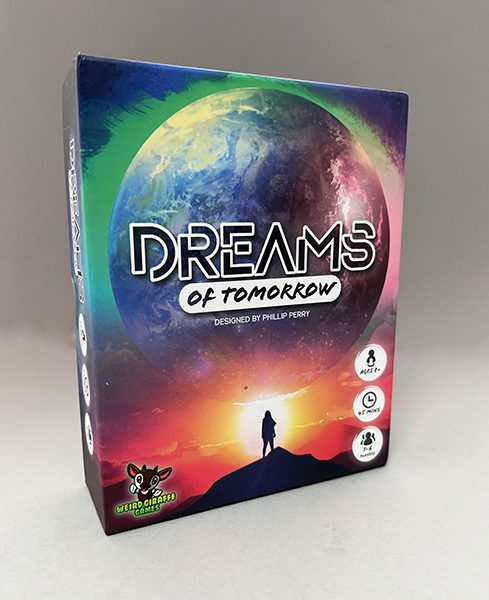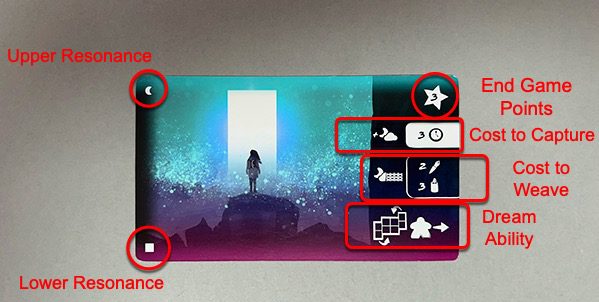Disclosure: Meeple Mountain received a free copy of this product in exchange for an honest, unbiased review. This review is not intended to be an endorsement.
In the future, humanity is on the brink of collapse. The people of that bleak time have determined the best chance for all mankind relies on the people of the past. If they can find a way to inspire their ancestors to make the necessary changes, civilization might be saved.
The path to salvation they choose is through dreams.
In Dreams of Tomorrow, you are a Dream Engineer, working to intertwine extraordinary, memorable dreams in hopes of encouraging those essential changes. By traveling the Dreamscape, you will use your Experience to catch fragments of dreams, then combining Creativity and Hope, you’ll weave those dreams into a sequence to be sent back in time.

After a set number of dreams have been collected, the Dream Engineer whose sequence has the most Dream Points wins.
Players Only Love You…
Players each take a player mat, as well as the cubes and single meeple of their preferred colors. Place one cube on the indicated square of each track: the six on the topmost, Experience track (clock icon), and the zero for both the Creativity track (paintbrush) and the Hope track (candle).

Place the four cards of the Collective Consciousness matching your player count within easy access of all players. Each card has a top and bottom segment, or Consciousness Fragments. These cards are placed starting side up and in numerical order. This forms the rondel around which turns will be taken.

Each player’s meeple is placed on the top section of the card to the far left.
Shuffle the Dream deck and place a number of them (based on player count) face up, above the Collective Consciousness. The Dream deck is then placed face down, next to these Dream cards.
The starting player then selects one of the face-up Dream cards. That Dream card is replaced by one from the deck and the next player chooses their own starting Dream card. This continues until all players have a starting card.
On the right side of each Dream card, at the top of the center area, is a number next to the Experience icon. This is the cost, in Experience, a player must pay to take the card into their area. Players start the game with six Experience, which is more than enough to purchase any Dream card.
Move your cube in the Experience (top) row down to match the cost of the Dream card. Then place the Dream card above your player mat in an area known as your Dream Catcher. Replace that card with the top card from the Dream deck and the next player selects a card, also paying its cost on the Experience track.
Once all players have selected and paid for a starting Dream card, you’re ready to play.
When You’re Playing
You will start moving clockwise around the Collective Consciousness rondel, as indicated by the Clockwise marker on your player mat. (This can change throughout the game.)
On a turn, you can move up to three spaces on the Collective Consciousness for free. Moving additional spaces will cost you a resource (Experience, Creativity, or Hope) of your choice.
Most Consciousness Fragment cards have two sections, an upper and lower area. You will collect the resources or take the action in the upper section. Your fellow Dream Engineers will take the resources offered in the lower section. Most of these cards will allow you and your fellow players to collect Experience, Creativity, and Hope. (Resources are not meant to be scarce for you and your fellow Dream Engineers.)

One Collective Fragment allows you to spend your Experience to Catch a Dream. This means you’ll trade Experience for a for a Dream Sequence that you will add to your Dream Catcher.
There are several reasons for Catching Dreams, including:
- Accessing the special Ability of each Dream Sequence
- For the Dream Points the card will grant you when/if you add the Dream to your Dream Sequence
- To create and expand the Resonance of the Dreams within your Dream Sequence
To get a better idea of all of this, let’s take a closer look at a Dream Fragment card.
In the upper right corner is a number in a star. This shows the number of Dream Points you’ll score for adding this Dream to your Dream Sequence.
Below that is the cost in Experience (clock icon) to Catch this Dream.
Under that are numbers next to the Creativity and Hope icons. This represents the cost of these two resources to Weave the Dream into your Dream Sequence.
At the bottom right is the special Ability of this Dream. Abilities vary and include:
- Reordering one or two of the Collective Consciousness cards and then moving one or two spaces
- Reordering any one Collective Consciousness card and moving one space
- Changing direction (either clockwise or counter-clockwise) and moving one or two spaces
- Flipping one Collective Consciousness card over and move one or two spaces
- Swapping places with another Dream Engineer and moving one or two spaces
- Trading in a resource to move anywhere on the Collective Consciousness
- Catching a Dream from the top of the deck or from the discard deck
- Clearing the Dreamscape and catch a Dream from the top of the deck or from the discard deck
- Gaining resources
- Exchanging Dreams between your Dream Catcher and your Dreamscape
The upper and lower left corners of a Dream represent the Resonance of each Dream. Adjacent Dreams with matching Resonance will score bonus points at the end of the game—the more Resonance, the more points you’ll score
IMG: Dream Sequence Card Details.
Two Collective Fragments allow you to activate any of the Dream Abilities in your Dream Catcher or visible on your Dream Sequence.
The lone Collective Consciousness location with the woven icon allows you to spend the appropriate Creativity and Hope to move a Dream from your Dream Catcher into your Dream Sequence.
Dreams added to your Dream Sequence are placed one atop the other, with only the Resonance symbols to the left remaining visible. Dream abilities that have been covered by another Dream can no longer be used.
Play continues until one Dream Engineer weaves the number of Dreams into their Dream Sequence as dictated by the player count. All players who have not taken a turn that round are allowed to do so and points are then tallied.
Say, Variations, They Will Come and They Will Go
There is a solo mode where you play against a Robot Player. On their turn, the Robot counts its turn on a card and then draws the top Dream card from the Dream deck. Based on the Resonance of that Dream card, the Robot then alters the order of the Collective Consciousness.After Weaving your fifth Dream, the Robot player’s score is a combination of the number of moves the Robot made, along with a set number of points based.
The Troubled Night variant introduces a Night Mare. This wooden horse starts with the last player and then moves counter-clockwise amongst the players.
After the player holding the Night Mare takes their turn, the Night Mare turns over the top card of the Dream deck. It then uses the same Resonance-based changes the Robot uses to alter the Collective Consciousness.
When the Rain Washes You Clean, You’ll Know
I am aware that Dreams of Tomorrow sounds a bit over-the-top. That’s because, theme-wise, it is.
This is a fairly straightforward card collection game, where you’re selecting cards for their special abilities and potential points. Since you’ll score for both the points indicated in the upper right corner and the matching symbols on the left, you’ll need to select cards carefully. Sometimes, though, you’ll take a card simply because of the special ability it grants you.
While I want to admire the writers of the rulebooks (yes, there are two of them for some reason) for the way they’ve doubled down on the Dreamscape and Dream Engineer theme, it quickly became too much for me. (I spared you the concepts of the id-tech and the id-naut. You’re welcome.)
I get the idea of theme, but don’t let your world-building get in the way of explaining how to play your game.
In short, the rule books take themselves way too seriously, especially for a theme that’s as pasted-on as this one is. The Glossary and Abilities from the second book should have been added to the main rule book and the unnecessary story at the end of the second rulebook could have been placed online.
The solo mode was somewhat challenging, but it turned Dreams of Tomorrow into a race, which took away some of what I liked about the game.
In most of my games, we spent a fair amount of time collecting Dreams into our Dream Catcher. For a majority of turns, we could make use of one of our Captured Dream’s Abilities to move further along the Creative Consciousness to land on the Dream Fragment we wanted to use. We’d eye one another’s Dream Weaver areas, wondering who would feel they had an optimal amount of Dream Points and Resonance and make a dash towards completing their Dream Sequence first.
And the first person to complete a Dream Sequence typically scored the points to win.
At first the Robot and Night Mare’s shuffling of the rondel cards was amusing. Soon, however, it felt like chaos for chaos’ sake. (Chaos with a purpose is fine by me. Chaos just to be chaotic, gets annoying.)
I will say that the Dream cards themselves are pretty. James Masino’s artwork is definitely dream-like. It’s probably my favorite part of the game.

If you can see your way past the attempts to impress you with the wafer-thin theme, Dreams of Tomorrow works as a family game or a quick filler—although there are others I’d recommend you consider first.
Sweet dreams.












Add Comment